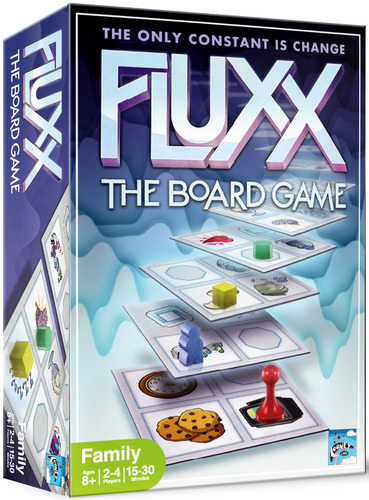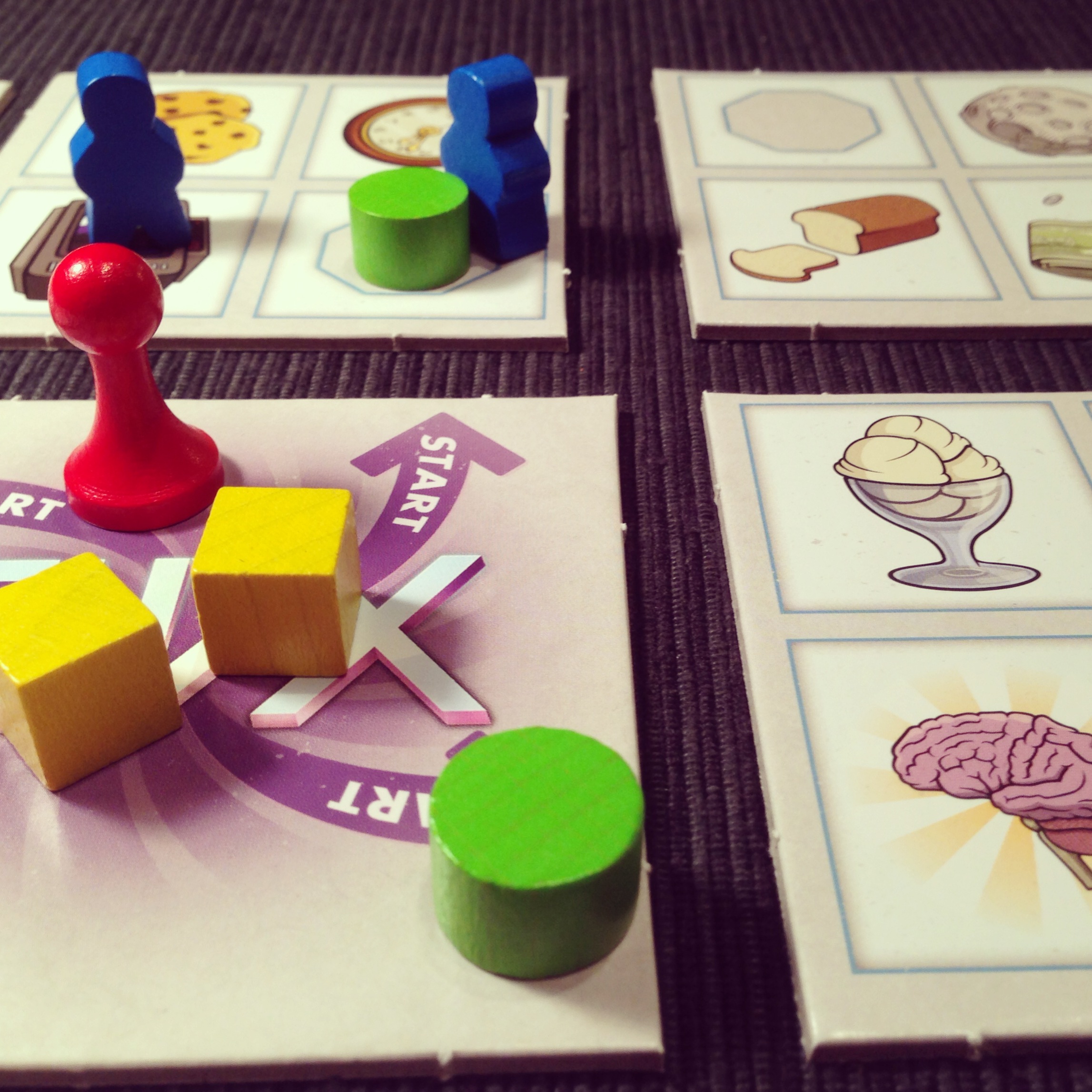Fluxx: The Board Game—A Double-Take Review
/We adore chaos because we love to produce order." ~M.C. Escher Looney Labs has turned their hit card game into a board game. Is it as chaotic as the card game? Is it completely different? Will Firestone actually like this game?! Let's find out!
The Basics
Fluxx: The Board Game is for 2-4 players, ages 8 and up, and takes 15-30 minutes to play.
The Components
12 wooden playing pieces in four different colors: 3 yellow cubes, 3 green cylinders, 3 red pawns, and 3 blue person-shaped pieces.
8 orange pegs
Tiles and pegboards
1 deck of cards
The Setup
Place a peg into the leftmost peg on each of the rules on the Rules pegboard, and into the 3 spot on the Win pegboard.
Place the Start tile in the center of the table, mix up the other tiles, and create a 3 x 3 square of tiles around that center Start tile.
Pick player colors, place all used pieces on the Start tile, and give each player the card that corresponds to his or her color.
Look through the deck and find the first five Goal cards and place them in a pile faceup on the Win pegboard.
Shuffle the cards and deal three to each player.
Before the game begins, everyone gets one free rule change. You can move any peg one space to the right (or up if you're moving the peg on the Win pegboard. You can move any peg, even if it's been moved by someone else, but you can never undo or reverse another player's move.
The Gameplay
Randomly determine a start player. On a player's turn, you'll just look at the Rules pegboard and do what it says. You'll be drawing 1-4 cards, depending on where the peg is. You'll be playing 1-4 cards, depending on where the peg is. You'll be moving 2-5 spaces, depending on where the peg is. And you'll have a hand limit of none, 3, 2, or 1 cards, depending on where the peg is.
You can play cards and make moves in any order you want, and can even alternate between them.
There are blue Action cards that make something happen. They might let you trade hands with another player, or force everyone to trade colors. There are yellow New Rule cards, that change the rules somehow. They might tell you exactly how to change a peg, or give you options on what to move. Green Leaper cards have one of the pictures from the tiles on them, and you just jump a piece to that space. Purple Goal cards are played onto the top of the Goal pile, so that becomes the current Goal.
The Start tile has four arrows leading out of it, and you can only leave using one of those arrows. You'll be moving and playing cards and trying to match the Goal card currently on the top of the Win board.
Most spaces have a picture of one thing on them: chocolate, sun, music, brain. Each space can only hold one piece. If you move onto a space with another piece, you bump it to an adjacent unoccupied space (other than the one you just came from).
Each tile has one octagon space, which can hold any number of players. There are also two Portal spaces. As soon as someone moves onto one of the Portals, that person is immediately transported to the other Portal space.
There are also Special Move rules. One allows you to rotate a tile as one of your moves. One lets you pick up a tile and move it to another space—as long as you keep the orientation the same and as long as it's still connected to the rest of the tiles. And finally, the Wraparound rule lets you move off of one edge of the board and wraparound to the other. You can even cross gaps left over from uprooting a tile this way.
Any time (even on another player's turn) that you have pieces on spaces that match the current goal, you take that card. And as soon as someone has a number of Goal cards matching the current win level on the Win board, that person...wins!
The Verdict and Recommendations
Firestone—It's no secret that I don't really like Fluxx. It's way WAY too chaotic for me. I'll play with my family, but I wouldn't call it my favorite family game by a long shot. But Looney Labs wanted me to play this anyway, because it was more strategic, they said. I was skeptical but open-minded. Well they were absolutely right.
Rather than being based completely on the luck of the draw, Fluxx: The Board Game feels more like a puzzle: Each turn is a little puzzle to solve. Sure, there are still cards to draw and luck there, but there's also more stuff you can do to affect your position. How can I get myself onto those two spaces using the rules, cards, and movement available to me? While there's still some chaos and luck, I felt as though I had more control than I EVER had in the card game.
Jeremiah—I, on the other hand, am a huge fan of Fluxx! Fluxx, if nothing else, is unique compared to anything else you will play—I love the way the game wreaks havoc with the players, causing them to readjust constantly. No, it's not very strategic—at times—but there's something about seeing the agony on your friend's face when they realize they HAVE to play a card that causes you to win!
Fluxx the board game captures a lot of the original feel of the card game but does a great job of creating a new experience for fans of the game and newcomers!
Firestone—The pieces are a mix of good and bad. The pegboards and tiles are all nice and thick, but the pegs are too long. So when the pegs are in, the boards won't sit flat on the table, and if you push the board down flat onto the table, some of the pegs pop out. The wooden pieces are nice and chunky, and the cards are all adequate—though very, very thin.
Jeremiah—I'm also not a fan of some of the components. Yeah the tiles are thick and sturdy, and the cards are good quality. But I wasn't a fan of the pegboard system, either. I love its function! Just not its form. One of the peg holes is a little loose, too, causing the peg to fall out. Maybe it's the Euro gamer in me, but I'd just rather have had a tracker token on a track for the rules.
Firestone—Yeah, even my wife, who isn't a gamer at all, asked, "Why didn't they just have wooden cubes that you move on a board to keep track of this?"
UPDATE: Amber from Looney Labs has contacted us to let us know that they have a solution: pieces you stick to the bottom of the pegboards to raise them up high enough for the pegs to fit fully in. Contact customer-support [at] looneylabs.com. Thanks Looney Labs!
One other small complaint is that they chose the vanilla Fluxx as the theme. I completely understand why they did it, since it's their flagship product, and the one most people will be familiar with. But it's also kinda...boring. A cookie. A sun. A glass of milk. A piece of pizza. Andrew Looney. Meh... I would have been all over a Star Fluxx: The Board Game. Maybe that's in the works, but asking people to buy multiple versions of a $10 card game is one thing. Asking them to buy multiple versions of a $30 board game is very much another... But that's just a personal preference.
Jeremiah—I was totally fine with the original Fluxx theme; it sets up the base for the offshoot of the franchise. I, of course, have no way of knowing Looney Labs' plans for the future, but I could see them selling expansion packs instead new complete versions. Swap out the tiles and the cards and you're set—you don't need new player tokens and rule boards etc. Of course, Zombie and Pirate Fluxx would make for some cooler meeple options!
I'm pretty impressed with the great synergy between the board/tiles, cards and rule trackers! The cards still have their Fluxxy charm, and the board adds some great decision-making moments as well.
Firestone—Yeah, but the decisions aren't overwhelming. I could see someone prone to analysis paralysis getting overwhelmed by all of the choices as they puzzle through things. But it probably won't be a problem for most people.
Jeremiah Final Thoughts—As a fan of Fluxx, I have to say, while I was excited about FtBG I was slightly nervous that it might be an obligatory attempt to cash in on the reputation of its successor. All of the fears have been put to bed soundly! This game is fun! It is very puzzle-like, and the way it allows players to shift and change the playing surface makes it very replayable. Fluxx: The Board Game is the M. C. Escher of board games. Put this game on your table!
Firestone Final Thoughts—Aside from the terrible pegboard implementation, I like this game a lot. It's very light, and unlikely to make it past a couple of plays with my regular game group. But my family and I really like this, and I actually think it's a great nongamer game. I agree with Jeremiah: Put this game on the table!
Thanks so much for reading! And if you want, you can watch the video review, too!

















